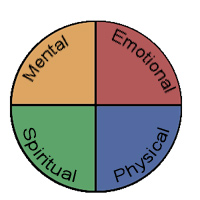How Can I Use Homeopathy to Improve Health and Well-Being?
Homeopathy can be used in many different ways in an individual's healthcare regimen.
Three common ways are:
- Self-care: individuals use homeopathic remedies to treat minor traumas and illnesses
- Acute care: homeopaths recommend remedies for acute illnesses
- Constitutional care: homeopaths recommend a program of remedies to optimize health
How can I use homeopathy for self-care and first-aid?
Basic homeopathic self-care can be very useful for acute and minor traumas and illnesses. Because homeopathy works to support the vital force of the body, it assists the natural ability of the body to heal faster.
Pharmaceuticals, on the other hand, work by suppressing symptoms, even the symptoms that are healing responses (for example, acetaminophen suppressing a fever). This can actually cause the body to take longer to recover from an acute injury (such as a sprain) or an infectious illness (such as cold or flu).
When doing homeopathy for self-care, it is critical to remember several things.
- Signs or symptoms of a potential serious illness require medical evaluation (for example chest or left arm pain, shortness of breath, severe dizziness or loss of consciousness, severe headache, fever of 102 or higher that persists for more than three days, blood in vomit or stool).
- If you are treating yourself homeopathically for an acute illness that persists without improvement for more than three days, seek professional help.
- Understand the difference between single remedy treatments for your acute symptoms (for which you can follow clear symptomatic responses to remedy and dose) and multiple remedy products that take the shotgun approach to your illness, but may complicate your condition by bringing on proving symptoms. (See What Are Homeopathic Remedies? to learn more about proving symptoms.)
- When selecting a remedy, remember to take into account the unique aspects of your complaint. For example instead of just stating that you have a sore throat, note the details: a left-sided sore throat with fever, irritablity, and sensitivity to touch, where you can't stand to have anything around your neck, but drinking cold water helps.
What Should I Put In a First Aid Kit?
It is possible to assemble a home first aid kit, which is handy to have for self-care and when a homeopath advises you over the phone to take something for an acute injury or illness.
 The easiest, and often the most economical, way to do this is to purchase an already assembled first aid kit. A typical home kit would have 30 to 40 remedies of 30c (the most common potency for self-care). Camping or travel kits may be as small as 10 to 15 remedies. These can be purchased through a number of different companies, some of which are listed below:
The easiest, and often the most economical, way to do this is to purchase an already assembled first aid kit. A typical home kit would have 30 to 40 remedies of 30c (the most common potency for self-care). Camping or travel kits may be as small as 10 to 15 remedies. These can be purchased through a number of different companies, some of which are listed below:
Certain remedies are more commonly used in children, so you might want customize the kit for you and your family's needs. You can purchase single remedies retail in a 12x to 30c potency range for about $8 to $14 per remedy. Guidelines and suggestions for specific remedies are available in many places, including this guide.
How can I use homeopathy for acute care?
Acute illnesses that are more serious, or longer lasting, can often be treated well with homeopathic remedies, but you should consult a professional homeopath. Close monitoring is necessary for optimal outcomes, as the homeopath may need to change the type and/or potencies of the remedies as the symptoms change.
For example, in the early stages of influenza, your early complaints may be high fever with generalized body aches. You try some over-the-counter Oscillococcinum, a homeopathic remedy which has been shown to improve flu symptoms, but is very non-specific.
Over a couple of days, your symptoms clarify. You are chilly and very irritable, your mucous membranes are very dry, and you are thirsty for large amounts of fluids at a time. You have a splitting headache that gets worse from the slightest motion. You speak with your homeopath, who advises you to take a 30c Bryonia from your first aid kit and check back in six to eight hours.
You may need to take further doses of Bryonia, or if your symptoms evolve, you may need a different remedy.
What is constitutional care?
The concept of a "constitution" is found in many systems of healthcare, including Ayurvedic, naturopathic, Traditional Chinese, and others. It is the idea that as an individual we have certain trends in our nature-for example, someone may tend to be cold, like to be coddled when ill, desire a lot of time out in the wind, crave fatty foods, or be given to melancholy.
 Each system of medicine has a way of clustering mental, emotional, physical, and spiritual traits into constitutional patterns, to better understand an individual and to help guide one's treatment when ill.
Each system of medicine has a way of clustering mental, emotional, physical, and spiritual traits into constitutional patterns, to better understand an individual and to help guide one's treatment when ill.
In homeopathy, a person's constitution is identified by a specific remedy picture, and that remedy picture is most often used to treat long-term disorders and sometimes acute illnesses. Some people will refer to this as being their "remedy," meaning their constitutional type.
Remedy selection based on the most distinct, individual symptoms that are truly characteristic of the patient-whether or not they are related to the chief complaint-is often called "constitutional" prescribing. The emphasis is placed on the nature or constitution of the patient.
This is the same as classical homeopathy, adhering strictly to the original principles laid down by Hahnemann. This contrasts with other ways of prescribing a homeopathic remedy, such as prescribing two or more remedies to be alternated or taken simultaneously, testing the compatibility of remedies with patients by electrical devices, or using needles to inject solutions containing homeopathic preparations.
Constitutional care is done for several reasons:
- It can be used as part of a preventive or optimal health routine. Identifying the similimum, which is the one remedy that would best fit the overall mental, emotional, and physical state of the individual, helps to rebalance and support the vital force to achieve optimal health and functioning. One's usual similimum is the same as their constitutional remedy, though sometimes an acute illness may indicate a different similimum for that situation.
- It can be used to address chronic or recurring healthcare challenges. It may require one or a series of remedies to help the body recover from the imbalance that exists and may be done in conjunction with conventional medical care, although good communication is needed. Some medications may interfere with the ability of the remedy to act, and a successful remedy may impact the need for, or dose of, the pharmaceuticals.
- Homeopathy may be used at the end of life for palliation or to ease transitions.
What Is the Frequency and Duration of Constitutional Treatment?
Homeopathic remedies are recommended in differing potencies and for varying durations. In addressing chronic problems, a prescriber may take a case and select a remedy that they prescribe as a one-time, one-dose treatment, with instructions for the client to then self-monitor and report back in four to six weeks.
 Once that response has been evaluated, if it appears that the practitioner chose the remedy well, he or she may suggest that the client repeat a dose at the same or higher potency, place the client on a daily (LM) remedy dose, or wait for a longer period of time without further treatment. This all depends upon the client's severity of symptoms and the strength of their vital force, any aggravation of symptoms, the level of improvement of symptoms, and the nature of the imbalance.
Once that response has been evaluated, if it appears that the practitioner chose the remedy well, he or she may suggest that the client repeat a dose at the same or higher potency, place the client on a daily (LM) remedy dose, or wait for a longer period of time without further treatment. This all depends upon the client's severity of symptoms and the strength of their vital force, any aggravation of symptoms, the level of improvement of symptoms, and the nature of the imbalance.
The possibilities are almost limitless, but, for example, if a prescriber identifies a clients' constitutional similimum, it impacts them on every level of being. The client may reach a point at which he or she is doing very well, without symptom complaints. At that point no further remedy is indicated.
But then life unfolds. He or she may suffer an extreme stress, like the loss of a loved one or another trauma, and symptoms may return. At that point, a dose of the constitutional remedy may be therapeutic. It could even be taken at the time of the stress, before symptom complaints occur, in a preventive fashion.
References and Further Reading
Buegel, Dale, MD, Lewis, Blair, PA-C, Chernin, Dennis, MD, MPH (1991). Homeopathic Remedies for Health Professionals and Laypeople. Pennsylvania: Himalayan International Institute.
Jonas, Wayne, MD, Jacobs, Jennifer, MD, MPH (1996). Healing with Homeopathy: The Doctors' Guide. New York: Warner Books.
Speight, Phyllis (1991). Homeopathic Remedies for Children. England: CW Daniel Co.

